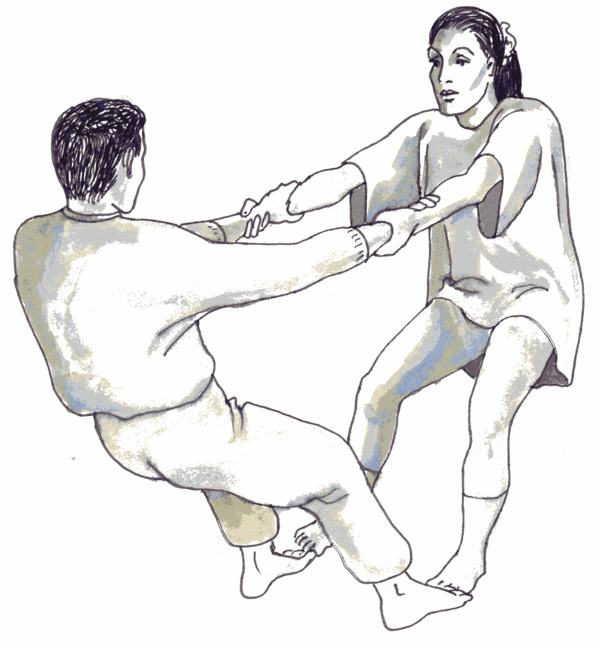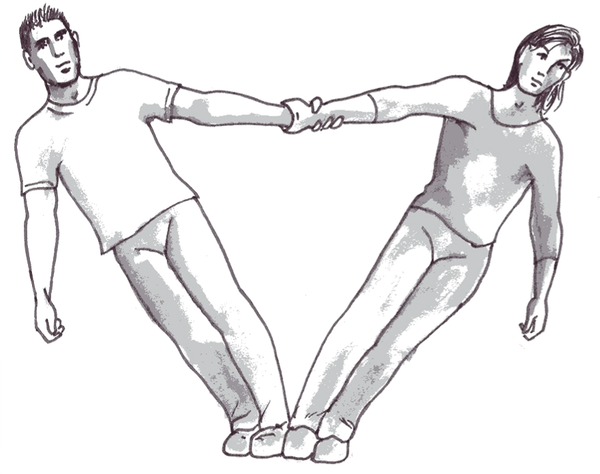| << Chapter < Page | Chapter >> Page > |
The warm up should take at least three minutes and no more than five minutes.
You should be breathing normally throughout the warm-up.
In order for you to do your dance successfully, trust needs to be established between you and your partner.
Your partner must be the same height as you are.
Face your partner and hold both his/her hands. Place your feet as close to your partner’s feet as possible and pull back with all your weight.
Hold this position for a while.

Stand next to your partner and face forwards. Hold one hand. Place feet together and pull away from each other.

Change hands while turning to face the backwards.
One of the partners stands with his/her back to the other partner. Take turns in falling backwards and being caught by your partner.
Combine these trust exercises into a sequence.
Explore simple arm movements.
Explore turning.
Note: This exercise is to be done without vocalisation, as you are to concentrate on balance and timing.
The previous trust activity acts as preparation for the Wedding Dance. This dance will be done with partners.
Use the information about a wedding ritual you have researched, and do the following:
Demonstrate your chosen wedding ritual to the rest of the class.
Choose from all the dances demonstrate one wedding ritual.
Step in lines and circles as in a procession.
Introduce opening/closing, swaying and turning actions to represent togetherness.
Work on motifs based on bowing, lifting, reaching, lowering, crouching, opening, closing, turning, kneeling, involving moving in unison, leading and following.
Share ideas and build up a ceremonial wedding dance made up of slow step patterns, clear body shapes and exaggerated gestures.
Choose ritualistic pieces of music with regular rhythms from several cultures.
Discuss the differences in spiritual expression between them.
Explore the emotion involved in a wedding ceremony.
Explore props and costumes used for a wedding ceremony.
It is important for the muscles used during the exercise to be stretched or you will have “stiff” muscles for about three days.
Choose music with a slow tempo.
Lie on you back on the floor, arms above your head and legs straight.
Lengthen your body by reaching with your arms and pointing your toes. Hold stretch for eight counts and release.
Bring arms to your sides.
Bend your knees, keeping your feet on the floor.
Bring one leg onto your chest. Hold the leg with both hands and pull toward your body. (Hold for eight counts) .
Straighten the bent knee and pull leg towards your head (do not force the stretch). Hold for eight counts.
Change legs.
Bring both legs into your body and hug your legs. Lift your head and shoulders slightly off the floor. Hold for eight counts.
.
Drop knees to the left side. Keep upper body and shoulders on the floor, with arms stretched to the sides.
Change to right-hand side.
Return legs to centre position. Sit up, with knees bent and hands on knees. Straighten your back. Pull your body forward between your knees, keeping your hands on your knees.
Slowly get up onto your feet by lifting your buttocks off the floor.
Slowly curl upwards, keeping knees bent. Head comes up last.
Shake all moveable parts of the body.
All stretches should be held for eight counts/beats.
The cool-down should not be shorter than three minutesor longer than five minutes.
All stretches should be done slowly to avoid injury.
| Learning Outcomes(LOs) |
| LO 4 |
| EXPRESSION AND COMMUNICATION The learner is able to analyse and use multiple forms of communication and expression in Arts and Culture. |
| Assessment Standards(ASs) |
| We know this when the learner: |
| MUSIC (4.4) |
|
| DRAMA (4.2, 4.3) |
|
|
| DANCE (4.1) |
|
| VISUAL ARTS (4.5, 4.6) |
|
|
|

Notification Switch
Would you like to follow the 'Arts and culture grade 6' conversation and receive update notifications?